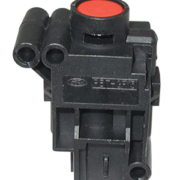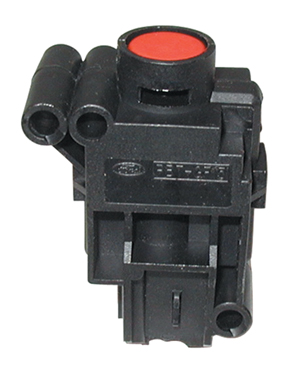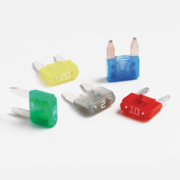Inertia Switch
We just posted details on how to wire the fuel pump to our Infinitybox POWERCELL. That was a very simple part of the wiring process in this 1967 Mustang. We received a follow up question to this post about wiring a fuel inertia switch. We’ll give details in this post.
A lot of manufacturers, Ford especially, use an inertia switch to interrupt the power going to the electric fuel pump in case of an accident. These switches use an internal magnet and a ball bearing to close the circuit providing power to the fuel pump. If there is a large impact to the car from a collision, the force of the impact knocks the ball out of its location. This opens a set of contacts in the switch, which interrupts power going to the fuel pump. These switches can be sensitive. They may shut down the fuel pump if you get a flat tire or if you hit a large pot hole. A lot of us here remember the prank of pounding on the driver’s rear fender in a mid-1990’s Thunderbird or Mustang to kill the fuel pump and leave a guy stranded.
If there was an accident, this switch opens and cuts off power to the fuel pump. There is a reset button on the top of the switch. If the red plunger is up, that means that the switch tripped. If you press down on the plunger, it will reset the switch, letting the electric fuel pump operate again.
In some cars, these switches are in the rear near the fuel pump. In other cars, they are up front behind the dash. Wiring an inertia switch to your fuel pump powered by our 20-Circuit Kit is really easy.
You can purchase these switches from any on-line source. This link will take to you the popular Ford switch sold on Amazon. You can find the switches but you can’t always find any data or specifications on them.
Switches are only designed to carry a maximum amount of current. You always have to consider that when you choose a switch. That is true when you pick your inertia switch. These switches were designed to interrupt the feed going directly to the fuel pump. This means that the switch was designed to carry the current for that pump. In the case of this 1967 Mustang, we are installing a higher-performance pump that draws much more current that the original OEM pump.
To be safe, use the inertia switch to interrupt the MASTERCELL input wire for the fuel pump. Each of our inputs only require a very small amount of current to operate. The contacts in the inertia switch can easily handle the small amount of current from the MASTERCELL.
Under normal operation, the MASTERCELL input will be connected to a switch that turns on the input for the fuel pump. This could be a signal coming from an ECU, it can be from a separate fuel pump switch or it can be tied to the ignition switch. The inertia switch would be wired in series. If there were to be an accident, the input from the MASTERCELL would be interrupted by the open contacts in the inertia switch. This would cause the MASTERCELL to send the command to the POWERCELL to turn off the fuel pump output. Wiring the switch in with the MASTERCELL input ensures that you will never overload the contacts on the inertia switch.
Click this link to contact our team with questions or comments on this post.



